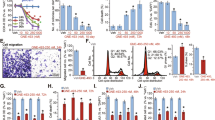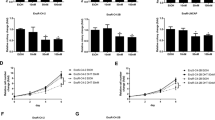Abstract
Background:
Berbamine (BBM) has been reported with antitumor activities. BBM inhibited the growth of prostate cancer (PCa) cells and caused vacuolization of mitochondria in preliminary study. We hypothesized BBM could enhance apoptosis of PCa cells through mitochondrial pathway.
Methods:
Growth of PC-3 and LNCaP cells treated by BBM was determined by cell viability assay. The morphology of mitochondria was observed by electron microscopy. Apoptosis was quantified by flow cytometry. Expressions of bax/bcl-2, active caspase-9 and active caspase-3 were examined by western blot and real-time PCR. Methazolamide, an inhibitor of cytochrome c, was added to examine its blockade effect on BBM. PC-3 cells were injected subcutaneously into athymic mice, and BBM or saline was administrated intravenously. Diameters of induced tumors were compared, and ratios of apoptotic cells in tumor tissues were calculated.
Results:
BBM inhibited viability of cultured PC-3 and LNCaP cells in dose- and time-dependent manners. Flow cytometry showed BBM induced apoptosis in cultured cells. Mitochondria showed swelling, vacuolization and fused mitochondrial cristae. Western blot and real-time PCR analysis both showed increases of bax/bcl-2, active caspase-9 and active caspase-3. Methazolamide impeded effect of BBM on inducing apoptosis of cultured cells, and activations of caspase-9 and caspase-3 were also inhibited. Growth of tumors by grafted PC-3 cells was significantly slower in BBM group. Ratios of apoptotic cells in tumors were significantly higher in BBM group. Expressions of active caspase-9 and active caspase-3 in tumors were significantly upregulated by BBM.
Conclusions:
BBM exhibited strong anti-PCa activities in vitro and in vivo relying on activating caspase-3 via intrinsic pathway of apoptosis, holding a great promise to develop new strategies for PCa.
This is a preview of subscription content, access via your institution
Access options
Subscribe to this journal
Receive 4 print issues and online access
$259.00 per year
only $64.75 per issue
Buy this article
- Purchase on Springer Link
- Instant access to full article PDF
Prices may be subject to local taxes which are calculated during checkout





Similar content being viewed by others
References
Wei YL, Xu L, Liang Y, Xu XH, Zhao XY . Berbamine exhibits potent antitumor effects on imatinib-resistant CML cells in vitro and in vivo. Acta Pharmacol Sin 2009; 30: 451–457.
Li SY, Jei W, Seow WK, Thong YH . Effect of berbamine on blood and bone-marrow stem cells of cyclophosphamide-treated mice. Int J Immunopharmacol 1994; 16: 245–249.
Gu Y, Chen T, Meng Z, Gan Y, Xu X, Lou G et al. CaMKII gamma, a critical regulator of CML stem/progenitor cells, is a target of the natural product berbamine. Blood 2012; 120: 4829–4839.
Xu R, Dong Q, Yu Y, Zhao X, Gan X, Wu D et al. Berbamine: a novel inhibitor of bcr/abl fusion gene with potent anti-leukemia activity. Leuk Res 2006; 30: 17–23.
Meng Z, Li T, Ma X, Wang X, Van Ness C, Gan Y et al. Berbamine inhibits the growth of liver cancer cells and cancer-initiating cells by targeting Ca(2)(+)/calmodulin-dependent protein kinase II. Mol Cancer Ther 2013; 12: 2067–2077.
Nam S, Xie J, Perkins A, Ma Y, Yang F, Wu J et al. Novel synthetic derivatives of the natural product berbamine inhibit Jak2/Stat3 signaling and induce apoptosis of human melanoma cells. Mol Oncol 2012; 6: 484–493.
Wang S, Liu Q, Zhang Y, Liu K, Yu P, Liu K et al. Suppression of growth, migration and invasion of highly-metastatic human breast cancer cells by berbamine and its molecular mechanisms of action. Mol Cancer 2009; 8: 81.
Duan H, Luan J, Liu Q, Yagasaki K, Zhang G . Suppression of human lung cancer cell growth and migration by berbamine. Cytotechnology 2010; 62: 341–348.
Wang GY, Lv QH, Dong Q, Xu RZ, Dong QH . Berbamine induces Fas-mediated apoptosis in human hepatocellular carcinoma HepG2 cells and inhibits its tumor growth in nude mice. J Asian Nat Prod Res 2009; 11: 219–228.
Rocca R, Moraca F, Costa G, Alcaro S, Distinto S, Maccioni E et al. Structure-based virtual screening of novel natural alkaloid derivatives as potential binders of h-telo and c-myc DNA G-quadruplex conformations. Molecules 2015; 20: 206–223.
Tan W, Zhou J, Yuan G . Electrospray ionization mass spectrometry probing of binding affinity of berbamine, a flexible cyclic alkaloid from traditional Chinese medicine, with G-quadruplex DNA. Rapid Commun Mass Spectrom 2014; 28: 143–147.
Wang T, Liu Z, Guo S, Wu L, Li M, Yang J et al. The tumor suppressive role of CAMK2N1 in castration-resistant prostate cancer. Oncotarget 2014; 5: 3611–3621.
Hou ZB, Lu KJ, Wu XL, Chen C, Huang XE, Yin HT . In vitro and in vivo antitumor evaluation of berbamine for lung cancer treatment. Asian Pac J Cancer Prev 2014; 15: 1767–1769.
Qiao W, Zhang W, Shao S, Gai Y, Zhang M . Effect and mechanism of poly (ADP-ribose) polymerase-1 in aldosterone-induced apoptosis. Mol Med Rep 2015; 12: 1631–1638.
Siegel R, Ma J, Zou Z, Jemal A . Cancer statistics. 2014 CA Cancer J Clin 2014; 64: 9–29.
Beltran H, Beer TM, Carducci MA, de Bono J, Gleave M, Hussain M et al. New therapies for castration-resistant prostate cancer: efficacy and safety. Eur Urol 2011; 60: 279–290.
Ravi P, Mateo J, Lorente D, Zafeiriou Z, Altavilla A, Ferraldeschi R et al. External validation of a prognostic model predicting overall survival in metastatic castrate-resistant prostate cancer patients treated with abiraterone. Eur Urol 2014; 66: 8–11.
Zhao Y, Tan Y, Wu G, Liu L, Wang Y, Luo Y et al. Berbamine overcomes imatinib-induced neutropenia and permits cytogenetic responses in Chinese patients with chronic-phase chronic myeloid leukemia. Int J Hematol 2011; 94: 156–162.
Lavrik IN . Systems biology of death receptor networks: live and let die. Cell Death Dis 2014; 5: e1259.
Li MX, Dewson G . Mitochondria and apoptosis: emerging concepts. F1000Prime Rep 2015; 7: 42.
Kluck RM, Bossy-Wetzel E, Green DR, Newmeyer DD . The release of cytochrome c from mitochondria: a primary site for Bcl-2 regulation of apoptosis. Science 1997; 275: 1132–1136.
Sesso A, Belizario JE, Marques MM, Higuchi ML, Schumacher RI, Colquhoun A et al. Mitochondrial swelling and incipient outer membrane rupture in preapoptotic and apoptotic cells. Anat Rec (Hoboken) 2012; 295: 1647–1659.
Scorrano L, Ashiya M, Buttle K, Weiler S, Oakes SA, Mannella CA et al. A distinct pathway remodels mitochondrial cristae and mobilizes cytochrome c during apoptosis. Dev Cell 2002; 2: 55–67.
Wang X, Zhu S, Pei Z, Drozda M, Stavrovskaya IG, Del Signore SJ et al. Inhibitors of cytochrome c release with therapeutic potential for Huntington's disease. J Neurosci 2008; 28: 9473–9485.
Kolenko VM, Uzzo RG, Bukowski R, Finke JH . Caspase-dependent and -independent death pathways in cancer therapy. Apoptosis 2000; 5: 17–20.
Benafif S, Hall M . An update on PARP inhibitors for the treatment of cancer. Onco Targets Ther 2015; 8: 519–528.
Ambrosini G, Adida C, Altieri DC . A novel anti-apoptosis gene, survivin, expressed in cancer and lymphoma. Nat Med 1997; 3: 917–921.
Tamm I, Wang Y, Sausville E, Scudiero DA, Vigna N, Oltersdorf T et al. IAP-family protein survivin inhibits caspase activity and apoptosis induced by Fas (CD95), Bax, caspases, and anticancer drugs. Cancer Res 1998; 58: 5315–5320.
Yang F, Nam S, Zhao R, Tian Y, Liu L, Horne DA et al. A novel synthetic derivative of the natural product berbamine inhibits cell viability and induces apoptosis of human osteosarcoma cells, associated with activation of JNK/AP-1 signaling. Cancer Biol Ther 2013; 14: 1024–1031.
Acknowledgements
This work was supported by grant from the National Natural Science Foundation of China (No. 81300629).
Author information
Authors and Affiliations
Corresponding author
Ethics declarations
Competing interests
The authors declare no conflict of interest.
Additional information
Supplementary Information accompanies the paper on the Prostate Cancer and Prostatic Diseases website
Supplementary information
Rights and permissions
About this article
Cite this article
Zhao, Y., Lv, J., Chen, J. et al. Berbamine inhibited the growth of prostate cancer cells in vivo and in vitro via triggering intrinsic pathway of apoptosis. Prostate Cancer Prostatic Dis 19, 358–366 (2016). https://doi.org/10.1038/pcan.2016.29
Received:
Revised:
Accepted:
Published:
Issue Date:
DOI: https://doi.org/10.1038/pcan.2016.29
This article is cited by
-
Cyclometalated Ru(II) β-carboline complexes induce cell cycle arrest and apoptosis in human HeLa cervical cancer cells via suppressing ERK and Akt signaling
JBIC Journal of Biological Inorganic Chemistry (2021)
-
Prostate cancer and prostatic diseases Best of China, 2018
Prostate Cancer and Prostatic Diseases (2019)
-
Berbamine suppresses cell viability and induces apoptosis in colorectal cancer via activating p53-dependent apoptotic signaling pathway
Cytotechnology (2018)



